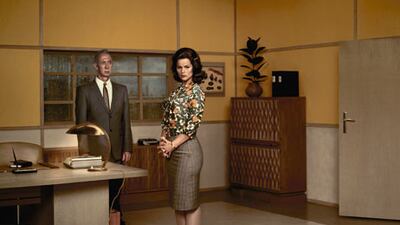A woman sits at a table looking serene with her Jackie Kennedy-Onassis hairstyle. White light streams in through thin, closed curtains behind her.
Art: The National looks
Exhibitions, reviews, news, features and all things art
But look closer, and she’s shielding a half-full glass of something. Look closer again and the black-strapped watch on her wrist reads quarter to 12. We’re invited to say, “It’s a bit early, don’t you think?”
The direct impact sought by war photos, reportage and advertising have become, as Erwin Olaf puts it, like being “slapped in the face”. But the scenes that this Dutch artist creates are lessons in the slowing, pacing power of detail.
Everything is staged, faked, using the same studio in Amsterdam for almost all his work. Olaf can build the fragile, mundane setting of a boardroom in 1950s America or an anonymous hotel room in Kyoto. It’s all just a matter of atmosphere and painstaking set design.
High Tension, at Dubai's Carbon 12 gallery, is a concise overview of his work from the past seven years. In 2011, Olaf bagged the Johannes Vermeer Award – the highest for the arts in the Netherlands.
It is fitting that he would be recognised now with an award named after one of the most famous Dutch masters, as the recent evolution of his practice has been influenced so much by painting.
“I shared my studio for a long time with a figurative painter and I was very jealous,” says the artist, when we meet on the opening night of his solo show. “You have two or three layers in a painting and I wanted to know how I could achieve that.”
Earlier projects, such as Chessmen (1987) and Mature (1998) – models geared up like masochistic chess pieces and provocative images of older women pensioners, respectively – embraced the immediate impact of a powerful image. But since 2000, the artist has looked for how best to slow his photographs down. This has extended into his prolific magazine work across Europe and the US.
After an initial revulsion to photo-editing software, Olaf has since embraced it. But its use is contained. There’s none of that shiny, opaque hyperrealism here that many manipulation-heavy photographers adopt. Instead, he uses it to control the viewer’s eye that bit more. “You move them through the image. That’s very painterly, Rembrandt knew how to do it with the depth of shadow.”
Add to this the care given to set design in each work and Olaf creates a layered photograph that we instinctively read slowly, building our own narrative as we do.
Hope – The Hallway and Rain – The Boardroom, two of the strongest pieces in the Carbon 12 show, were enquiries into how best to represent a charged moment, he says.
In Hope, a man and a woman stand in an apartment block corridor. The man seems to have just turned away, his face a startled void.
“I told the actors, the girl has said to her boyfriend, ‘I don’t love you anymore.’ That’s all I said. This is that split second between action and reaction. It’s one of the most important seconds that you’ll ever have.”
Olaf created Hope in 2004. "After 9/11, I felt society was caught in this moment of reaction and action. This thought led to me looking more at the United States, and I came to Norman Rockwell." Indeed, there are traces of Rockwell's 1950s America in the formalism of these shots. But some underlying decay, an unnerving lonely centre, has taken hold. "I realised that Rockwell was gone. Instead, we're left with Edward Hopper," says Olaf, referring to the isolation that each character broods over in his work. "That's where we are now."
High Tension offers a timeline of the artist's recent development of ideas, from the 1950s-inspired Hope and Rain, the suburban housewife world of the 1960s in Grief ("the start of the collapse") and through to the recent global economic crisis, represented in the Liberation series, depicting the breakdown of a marriage in the wake of financial meltdown.
"What is our future, where will we go to? There's boredom in all this buying – how much Chanel can you wear?" Olaf explains that Liberation was shot for a French daily newspaper. He was asked to create a shoot that reflected the global crisis, and chose to use clothing to help make his point, ending the series with a disturbing image of a woman, clad in high-end fashion, walking away as her husband swings by his neck in the parlour room.
Dark stuff, indeed. Each of the images in High Tension invites us into a fishtank world of Olaf's creation. We read them slowly, picking our way through until we come upon the disturbing kernel of story at their centre. Then, if they're successful, we're caught there – held over a shadowy abyss between action and a rather uneasy reaction.
High Tension continues until November 10. www.carbon12dubai.com.
Follow us on Twitter and keep up to date with the latest in arts and lifestyle news at twitter.com/LifeNationalUAE

